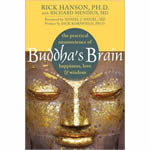
 Hanson, R. (2009). Buddha’s Brain: The practical neuroscience of happiness, love, and wisdom.
Hanson, R. (2009). Buddha’s Brain: The practical neuroscience of happiness, love, and wisdom.
Reviewed by: Anny Reyes, New York University
Neuroscience is being widely used to explain concepts and ideas that were once separated from science, such as religion, spirituality, and contemplative practices. Experts in these fields are utilizing basic neuroscience such as neuroanatomy, neurophysiology, and evolutionary biology to explain concepts and applications to their areas of expertise. Understanding our mind, how it functions, and how we can gain control over it has been one of the world’s most preeminent challenges. Some of the greatest philosophers, Descartes, Aristotle, and Locke, dedicated their lives to understanding the mystery of the mind and its relationship with the 3-pound organ that controls every mechanism in our body, the brain.
In the introduction Hanson outlines the format of the book, its purpose, and how it could be put into practice. He explains how neuroscience research supports the idea that you could use your mind to change your brain and ultimately change your life. The book is then divided into four parts: the causes of suffering, happiness, love, and wisdom, which are the central themes of Hanson’s Buddhist beliefs and framework. The first part of the book provides a comprehensive background on basic brain anatomy, brain mechanisms, and how our brains give rise to emotions. Hanson also provides evolutionary explanations for emotions and our reactions to everyday situations and to life’s more traumatic experiences. The research was relevant and the explanations as to the causes of suffering were very straightforward.
However, the later chapters follow a less evidence-based framework. This is an area where experts in a field outside neuroscience must be cautious not to make conclusions based on assumptions or personal opinions. Neuroscience follows an empirical framework and anything that’s not scientifically proven is not taken at face value, therefore when using neuroscience research to explain certain concepts, only evidence-based explanations should be provided. Overall the book is moderately well researched, some chapters more than others. Despite the lack of relevant research in certain parts of the book, Hanson provides a great overview of the different concepts and practices related to the three themes of the book, happiness, love, and wisdom.
Hanson, R. (2009). Buddha’s Brain: The practical neuroscience of happiness, love, and wisdom. ISBN: 978-1-57224-695-9.
Paperback. 251 pages.
Contains references, forward, and preface.
